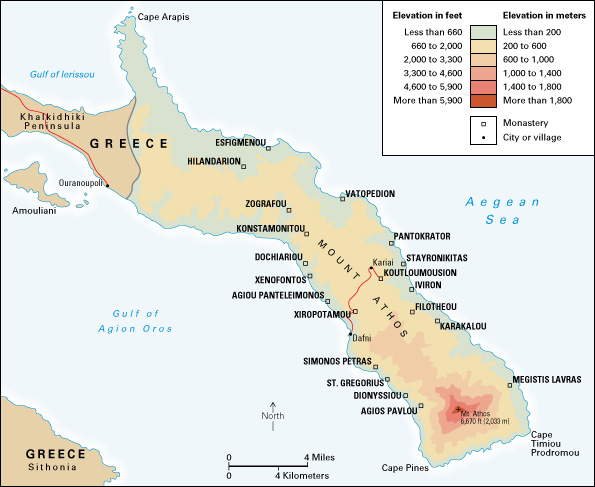Mount Athos, << AH `THAWS,` A `THAHS,` or AY `THAHS,` >> is a largely self-governing region of northern Greece that consists of a mountain on which about 20 Greek Orthodox monasteries and dependent communities are located. The Greek name for Mount Athos, Ayion Oros << AH yee awn AW RAWS >> , means “Holy Mountain.”

Mount Athos rises sharply from the sea at the southern tip of the Akti promontory. This promontory is the most easterly of the three that jut out from Macedonia into the Aegean Sea to form the peninsula of Khalkidhiki. Mount Athos, which is 6,670 feet (2,033 meters) in height, is composed of marble. It stands at the end of a chain of mountains running along the 30-mile (48-kilometer) spine of the promontory. Most of the monasteries hug the wooded coast of the Akti promontory. They mostly consist of a fortified set of buildings clustering around a central frescoed church. Above them, hermitages cling perilously to the sheer cliffs. The capital and only town of the Mount Athos region is Kariai.
Though a part of Greece, the region of Mount Athos functions like an independent monastic republic. The Greek government is represented by a governor, called a didoikitis, who also controls the local police force. But the region is administered by a Holy Council composed of representatives of all the monasteries. Church matters fall under the authority of the Ecumenical Patriarch.
In keeping with a local tradition, no women or female animals are allowed to enter the religious communities of Mount Athos. This practice is said to have arisen from a legend that told of how the Virgin Mary, traveling by sea to Cyprus, was forced to put in at the Bay of Iviron. She fell in love with the fertile, flower-filled meadows and wooded coast around Mount Athos. She called it her own private garden and forbade any other woman to enter it. When Saint Athanasius the Athonite devised his rule for the community of Mount Athos in the 900’s, he took account of this tradition.
The importance of Mount Athos as a religious center dates back more than 1,000 years. Religious hermits began living on the mountain in the 700’s. In 963, Saint Athanasius the Athonite founded the first monastery on Mount Athos. The hermits opposed organized monasticism but were forced to accept the rule of Saint Athanasius by the Byzantine emperor John I Tzimisces, from whom Mount Athos received its first charter (see Byzantine Empire ). More monasteries were built between 1000 and 1542, financed by princes and statesmen who recognized Byzantine authority. By the 1400’s, 40 monasteries operated on Mount Athos. Many monasteries were paid for by Russia and other Slavic countries. As a result, Mount Athos was for some time home to representatives of nearly all the Eastern Orthodox faiths (see Eastern Orthodox Churches ).
Supported at first by the already declining Byzantine Empire, Mount Athos became a major center of Byzantine religious art. Artists from Constantinople, Crete, and Thessaloniki came to Mount Athos and decorated the walls of its many churches with beautiful frescoes. Many of these frescoes still survive. The artists also taught the monks how to make and paint icons. In addition, Mount Athos became a center of religious learning and housed fine libraries filled with ancient and medieval manuscripts. Some of these libraries were destroyed when the Ottomans attacked Mount Athos during the Greek War of Independence (1821-1829). During the 1800’s, the Russian czars gave money and other resources to the Russian-endowed monasteries. A rise in the number of novices (trainee monks) from Russia and eastern Europe threatened to overwhelm the Greek element of the community’s population, but the Russian Revolution of 1917 and the events of World War II (1939-1945) ended this trend. By the late 1900’s, the number of monks on Mount Athos had declined from a maximum of 40,000 to about 1,500.
